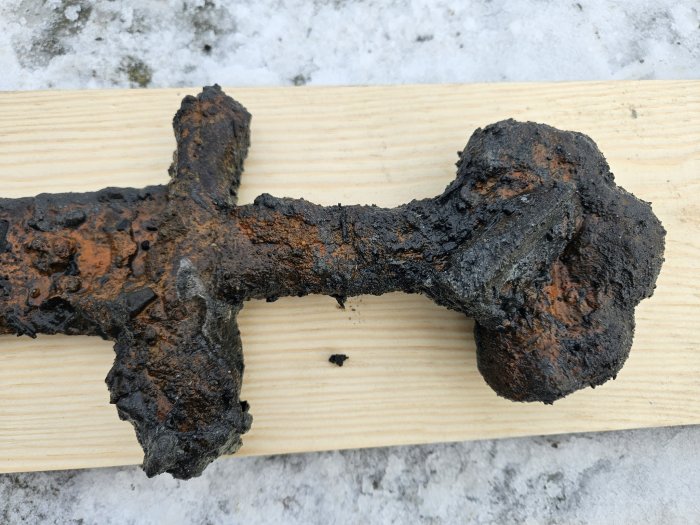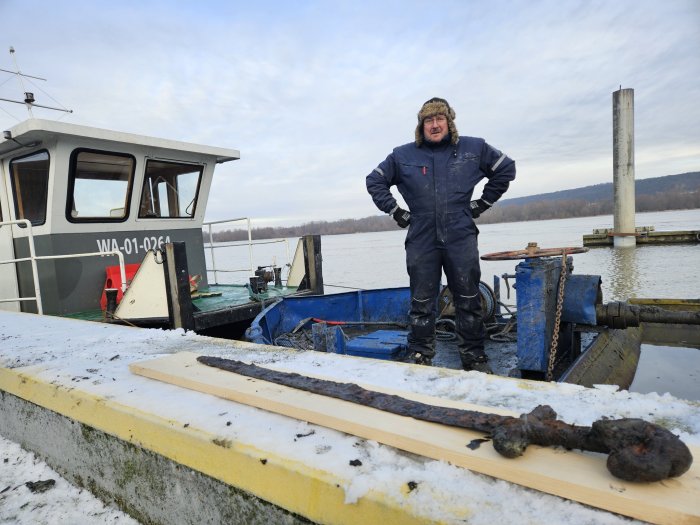Jan Bartek – AncientPages.com – Ulfberht swords were famous for their strength, flexibility, and high-tech blades. Viking warriors highly prized these weapons, which were extraordinarily valuable because of their properties.
This well-preserved Ulfbrecht sword was found in the Wisla River in Poland. Credit: Wojewódzki Urzad Ochrony Zabytków w Toruniu – O. Popkiewicz
“Ulfberht blades were made of crucible steel with relatively high carbon content, making them more robust and flexible than European swords during the Viking and Middle Ages. Crucible steel could not be produced in Europe until the Industrial Revolution in the 18th century. Still, in India, such steel (known as wootz, has been manufactured since 300 BC and has spread to large parts of the Middle East during the 9th century. Vikings probably gained access to the material from Persia via the trade route across the Volga and the Caspian Sea.” 1
Very few Ulfberht swords have been found so far. Only eight such swords are known to exist in Poland and 170 in the rest of Europe.
Earlier this month, Polish workers accidentally found a well-preserved 1,000-year-old Ulfberht in the Wisla River (Vistula River) in the city of Wroclawek. They were carrying out dredging work related to deepening the pool of the port of the Sport and Recreation Center in Włocławek when they suddenly made an unprecedented historical discovery.

The sword had an Ulfberht inscription. Credit: Wojewódzki Urzad Ochrony Zabytków w Toruniu – O. Popkiewicz
One can imagine how surprised Sławomir Mularski, the owner of the company, was when he spotted ‘an oblong, metal object’ sticking out of the sediment.
Experts suggest the sword may have belonged to a Viking, but this has not been confirmed. Scientists from the Nicolaus Copernicus University in Torun have conducted an X-ray analysis of the weapon and dated it to before 950 A.D. The sword also has an inscription of the word ‘Ulfberht.’
This historical period is highly important in Polish history. Poland did not exist prior to the 10th century A.D. when the formation of the House of Piast, the first historical ruling dynasty of Poland, took place.
Weapons of this kind are ᴀssociated with Scandinavia and the Frankish Empire.

Credit: Wojewódzki Urzad Ochrony Zabytków w Toruniu – O. Popkiewicz
“This is an extremely valuable find. We know that these so-called Ulfberht swords were produced somewhere in Central Europe, but it’s not known exactly where.
They were manufactured using very specific methods using carbon steel and a very precise composition.
The amount of carbon steel that was used was strictly defined, making the sword very strong and flexible – its durability and combat value depended on this.
More importantly, after lying in silt for over 1,000 years, the sword has been preserved in excellent condition,” Sambor Gawinski from the Kuyavian-Pomeranian branch of the conservator’s office said.
Gawinski stressed he was not convinced this was a Viking sword. “Several theories have been posited, and so far, all variants are acceptable, but we need to wait for the results of more detailed research,” he said.

Credit: Wojewódzki Urzad Ochrony Zabytków w Toruniu – O. Popkiewicz
Polish archaeologist Robert Grochowski agrees it is much too early to say a Viking once owned this sword. These swords are often referred to as Viking swords, but they were technically created in territories in today’s Germany and traded widely throughout Europe. This could explain why the sword was found in Poland.
See also: More Archaeology News
“I don’t know where the idea that the sword belonged to a Viking comes from. Without detailed research, this is completely unjustified. It is difficult to say anything more than the fact that it is an early medieval sword,” Grochowski told the Warsaw-based newspaper Gazeta Wyborcza.
Written by Jan Bartek – AncientPages.com Staff Writer
Expand for references
- Ellen Lloyd – Unravelling The Mystery Of The Ulfberht Sword – An Ancient Viking Artifact Far Ahead Of Its Time – AncientPages.com
- Wojewódzki Urzad Ochrony Zabytków w Toruniu – Facebook





